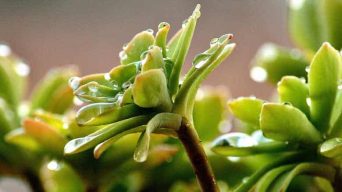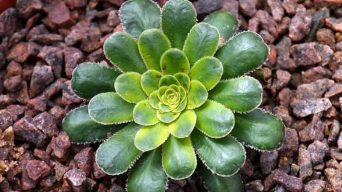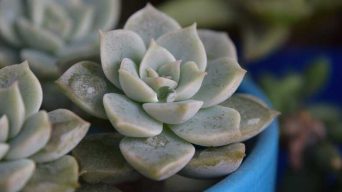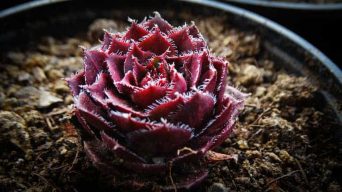Succulents are beautiful plants that can be grown in pots. They’re perfect for those who want a green thumb but don’t have the time or energy to maintain a garden.
Succulents make great additions to gardens because they require little care and can thrive for years with minimal attention.
But what do you do if you want to plant succulents without drainage holes?
If you find yourself needing to plant and water succulents in pots without drainage holes, this article is for you!
It will tell you how to do it properly, so your plants live long and healthy lives.
Do Succulents Need Drainage?
Succulents need well-drained soil and pots with draining holes to grow well and thrive. This is because they have adapted to thrive in drought conditions.
In the wild, these plants live on rocky hillsides or in the desert where rainfall is infrequent, but it tends to be in heavy downpours when it does rain.
For this reason, succulents are sensitive to wet soil and will rot if the roots are exposed to standing water for too long.
Succulents need a good drainage system for their roots – this means that water should be able to drain freely from the bottom of your container without pooling.
If your succulent soil mix does not drain well, you might find that the roots of your plants will begin to rot.
At first, you might see discoloration of the roots or a slimy texture to them. If the succulent root rot is left untreated, it could spread into the leaves and kill your succulent plant.
Pots with drainage holes help prevent overwatering by allowing excess water in the potting mix to drain away through it at a controlled rate. This means that the plant will not sit in water for too long and allow the roots to become waterlogged.
If you do not want to use a container with drainage holes, there are a few things you can do to ensure that your succulents receive enough water without drowning the roots.
How to Plant Succulents in Pots Without Drainage Holes
When growing succulents in pots, whether in the garden or on a patio, drainage is essential. It allows for excess water to drain away from the roots and triggers root growth when it begins to dry out.
Planting succulents without drainage holes can pose some problems, but there are ways to plant succulents in pots without drainage holes.
Choose the Right Pot
When planting succulents in pots without drainage holes, it is important to choose the right pot.
The Size of the Pot
The size of the pot is important because succulents need room to grow.
If the pot is too small, there will not be enough space for the roots to develop, which could stunt plant growth.
As a general rule of thumb, choose a pot that is at least one to two inches bigger than the plant’s root ball.
The Material of the Pot
Succulents grow best in porous pots, such as terracotta or glazed ceramics, because they allow keeping the soil from retaining too much water, which can drown the roots and kill your succulent.
If you wish to use a non-porous pot, such as plastic or metal, consider lining the bottom of it with gravel.
This will allow excess water to drain away and prevent root rot.
Try to avoid planting succulents in glass containers, as they do not provide drainage.
Use a Cachepot
A cachepot is a decorative container that fits over the top of the actual pot.
This can be used to hide large pots and give your succulents more height without taking up extra space in your garden bed or on a patio.
A cachepot will also help keep excess water from draining into the soil, which may cause it to become soggy and kill your succulents.
Use the Right Potting Mix
When growing succulents in pots without drainage holes, it is important to use the right potting mix.
Add Drainage Material
Adding drainage material such as rocks or gravel to the bottom of your pot will allow excess water in the soil to drain away.
This will prevent your potting mix from becoming soggy and killing your succulents.
Use Cactus Potting Soil
Succulents grow best in cactus potting soil because it drains well and has good aeration for healthy root growth.
There are many potting mixes, but cactus soil is specifically designed for succulents and can retain water while still allowing it to drain away from the roots.
You should avoid using a regular potting mix, which will retain too much water and cause root rot.
Make Your Own Potting Mix
Another option is to make your own potting mix.
You can use two parts of cactus soil and one part perlite to create an excellent mix for succulents in pots without drainage holes.
This will provide good aeration while allowing excess water to drain away from the roots, preventing root rot.
Planting Succulents without Drainage Holes
When planting succulents in pots without drainage holes, it is important to plant them properly.
1. Clean Your Pot
Before you plant your succulents, clean the pot out with soap and water to remove any dirt or debris that could prevent moisture from draining away.
After cleaning the pot thoroughly, allow it to dry completely before planting.
2. Add the Potting Mix
Once the pot is clean, add rocks or gravel to the bottom of it.
Fill the pot with cactus soil to about two inches from the top of it and plant your succulents around that level, leaving room for growth.
When planting a succulent in a pot that does not have drainage holes it is essential to ensure that the potting soil is very dry before planting.
3. Plant Your Succulent
Once you have added rocks or gravel at the bottom of your pot and put the potting mix on top of it, you can plant your succulents.
Dig a hole in the soil that is deep enough to fit its roots and sprinkle some cactus potting mix on top of the exposed roots. Gently spread out any clumps or tangles as you go.
Once your succulents are planted, fill in around them with more potting mix until the soil comes to about two inches below the top of your planter.
4. Don’t Water Immediately
After planting your succulents, you should allow them to dry out completely before watering again.
If possible, don’t water for one week or more to give the roots time to take hold in their new soil and recover from transplanting shock.
Allow any excess water in the top of the planter to drain away naturally without disturbing your plants when you water the rest of your plants in the garden.
How To Water Succulents Without Drainage Holes
Succulents are popular houseplants because they don’t require much maintenance.
However, if you want to plant succulents in pots without drainage holes, a few things need special attention when it comes to watering them.
The problem with planting succulents in pots without drainage holes is that the water has nowhere to go. This can cause the soil to become soggy and rot the roots.
For this reason, it’s important to know how much water to give your succulents and how often.
How Much Water To Give Succulents In Pots Without Drainage Holes
If you want to plant succulents in pots without drainage holes, it’s important to know how much water they need. If too little or too much water is given, the succulents can die.
You need to give enough water so that all of the soil is wet to around an inch down but not so much that water is pooling in the pot.
To determine how much water to give your succulents, you can provide them with some water at a time until about an inch of the pot is wet. You don’t need to soak the soil, though too much water will cause it to pool in small pockets.
You can measure the amount of water you’re giving your succulents to ensure it isn’t too much or too little. You can use a measuring cup or another tool to measure how much water you’re giving them.
How Often To Water Succulents In Pots Without Drainage Holes
When planting succulents in pots without drainage holes, it’s important to know how often they need water. If the soil is constantly wet, rot can set in and kill them.
The key to watering succulents without drainage holes is letting their roots dry out a bit before giving them more water. If you want to plant succulents in pots without drainage holes, it’s important not to leave their roots constantly damp for long periods.
It’s best to water succulents in pots without drainage holes once every two weeks or so. If you water them too often, the roots will become soggy and rot, which can kill them.
You can use a moisture meter to test the soil and see if it’s dry before watering your succulents again.
If you don’t have a moisture meter, you can stick your finger in the soil to feel how wet it is-if only one inch of the pot feels damp, then give them some water.
Watering Succulents In Pots Without Drainage Holes At The Right Time
Another important factor in watering succulents in pots without drainage holes is when to do it. The best time to water succulents is in the morning or early evening.
Watering succulents in the morning or evening is important because their leaves dry out faster when they’re not watered during the hottest part of the day.
So, if you want to plant succulents in pots without drainage holes, water them every two weeks and do it either in the morning or evening so that their leaves aren’t wet during the hottest part of the day.
How To Water Succulents In Pots Without Drainage Holes
Another aspect of watering succulents in pots without drainage holes is how to go about it. It’s important not to over-water them, but giving them enough water can be challenging when you don’t have drain holes.
Several tools allow you to properly water your plants while preventing the soil from becoming soggy. One such tool is a “self-watering” pot.
Self-watering pots work by letting water sit at the bottom of the pot and then slowly soaking it up through their porous sides. This allows plants to get many days or even weeks’ worth of water without needing to be watered again.
Another tool that can help you water succulents in pots without drainage holes is a watering can. It’s best to use a watering can with a narrow spout that allows you to get water into the soil but not pool on top of it.
You can also use a “watering wand,” which is like a watering can but with the spout at the end of a long tube. This allows you to water your succulents without getting their leaves wet.
If you don’t have either of these tools, you can also use a spray bottle to water them. Just make sure only to spray the soil and not their leaves. Misting their leaves too much can cause them to rot.
Final Thoughts
Growing succulents without drainage holes is possible.
However, growing succulents without drainages holes does present some challenges, and you should not expect your plants to thrive in this way.
Since succulents are sensitive to overwatering, people who grow them without drainage holes need to be careful and closely monitor their watering practices.
If you want to try growing succulents this way, make sure that you start with small plants and monitor them closely.







